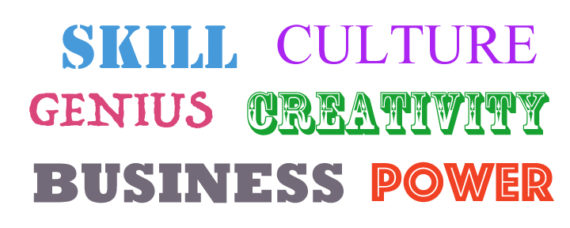Six theories about ART
‘What it means and what to do about it’
This blog post, concerning six possible theories about art, is based on my notes and preliminary ideas for a new book. The basic concept calls for much more research and time, and much less procrastination, and fewer competing priorities. So who knows whether the book will ever get written.
But here, in a thousand words, I am sharing with you an outline of the subject matter. Please let me know what you think.
Art is …. Skill, Genius, Creativity, Power, Culture, or Business.

Theories 1-3 focus on the artist. Art is a product of individual artists who decide what art to create.
Theories 4-6 focus on society. Art is something that artists make for society as a whole.
-
Art is a Skill
Art is a skilled craft, which can be taught, learned, and improved with practice. Artists possess the ability to use and demonstrate this skill.
 What this means for artists;
What this means for artists;
Your art should get better by practising your craft.
People will admire your dexterity and skilful use of medium because they recognise that they couldn’t do it.
Artists will choose art styles that demonstrate skill.
Abstract art is less suitable than subjective art such as portraiture, landscape, or still life.
There are tricks and techniques that can greatly assist demonstrations of skill such as photography, light boxes, photoshop, etc.
What this means for art lovers and critics;
People admire dexterity and skilful use of medium because they recognise that they couldn’t do it.
To some observers skilful art will seem to be empty and pointless.
What this means for the art business;
Reasonably easy to distinguish between skilful and not so skilful.
-
Art is a product of Genius or talented outsiders
An artist is a gifted visionary who can recognise and create beauty and quality that others cannot. Recognising qualities, even though others might know about these nuances. That’s why artists get paid so highly. (Irony)
 What this means for artists;
What this means for artists;
Opportunity to make art that expresses new and exciting ideas.
Artists have a duty to make and share their art because they have a rare gift.
Artistic geniuses can be awarded high social status.
What this means for art lovers and critics;
Opportunity to support and share genius.
Patronage for, and participation in, the arts.
Recognising and understanding the art demands special ability.
What this means for the art business;
Artist geniuses are rare and therefore their art is rare and valuable.
Art lovers can be shown how and why the art is the work of genius or especially talented people, and assisted towards patronage and participation activity.
-
Art is Creativity
Art is a natural process, making art for arts sake is a common enjoyable biological activity. Humans want, seek and need newness.
 What this means for artists;
What this means for artists;
Abstract art, and jazz, are good examples of expression of art for its own sake.
Making and creating is interesting and emotionally rewarding activity.
Mixing with other artists and participating in the art creation world is fun.
Rhythm and dance, song and pattern are natural neural pleasures.
What this means for art lovers and critics;
Mixing with artists and participating in the art creation world is fun.
Rhythm and dance, song, and pattern are natural creative neural pleasures.
Art is not an intellectual challenge but it can be appreciated emotionally.
What this means for the art business;
Wide audience possible for art because it is felt not learnt.
-
Art is a Socio-economic product that reflects power base
Art is caused by historical and social forces, as well as personal circumstances of artists.
Retrospective analysis can confirm the link between art, artists, and the power base.
 What this means for artists;
What this means for artists;
Artists are created by fitting into spaces and filling vacuums in the social mix.
Artists provide product that demonstrates and enhances the interests of leaders in a society.
Artists can provide art that acts as symbols for challengers to social hierarchy.
What this means for art lovers and critics;
Patrons can support social causes by supporting styles of art.
Art styles reflect socio-economic conditions.
Artists and art lovers may not recognise the strength of the power base influence at the time of creativity and use of art.
What this means for the art business;
Rich and powerful will support art that enhances their position.
New art can be adopted, recognised, as symbolic of new societal players.
Audiences that support or challenge strands or movements in society can be attracted to the art.
-
Art is Culture
Art is a group language, recognised by peers, mysterious to outsiders.
 What this means for artists;
What this means for artists;
Artists learn and then work in the language of special groups.
Artists make art that reflects the agreed values of a particular society.
What this means for art lovers and critics;
There is a historical worldwide cultural value of good quality art.
Art can be misunderstood by others who don’t appreciate cultural values.
What this means for the art business;
Art business is a valuable partner in society serving a useful role in social cohesion.
Art business is socially accepted and justified.
-
Art is Business
Art is commodity created and promoted as a product to make money, and is often a delusion or conspiracy.
 What this means for artists;
What this means for artists;
Making art can be a way of making a living either as a conspirator or a victim of the common delusion.
Fame and fortune are possible as dealers big-up art.
What this means for art lovers and critics;
Art might be a worthless local delusion that could be seen as a mistake later.
Art might be a conspiracy by special groups.
What this means for the art business;
Value can be created by using marketing techniques.
Stress on investment potential
The sky is the limit.
Business, Culture, Power, Creativity, Genius, Skill.
Examples can be found that support all six theories.
Some art, and some artists, will combine more than one theory.
Some art is specific to only one theory.
Some theoretical positions are mutually exclusive.
No one theory is absolutely right for all art and no one absolutely wrong.
The perspective of the viewer is a large factor in the relevance of a particular theory to art.
So…what do YOU think?




